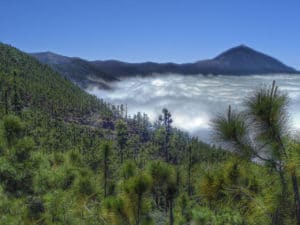Extending to 1,214 km (754 mi), the Portugal–Spain border is the longest uninterrupted border within the European Union.
Spain also includes the Balearic Islands in the Mediterranean Sea, the Canary Islands in the Atlantic Ocean and a number of uninhabited islands on the Mediterranean side of the Strait of Gibraltar, known as plazas de soberanía (“places of sovereignty”, or territories under Spanish sovereignty), such as the Chafarinas Islands and Alhucemas. The peninsula of Vélez de la Gomera is also regarded as a plaza de soberanía. The isle of Alborán, located in the Mediterranean between Spain and North Africa, is also administered by Spain, specifically by the municipality of Almería, Andalusia. The little Pheasant Island in the River Bidasoa is a Spanish-French condominium.
There are 11 major islands in Spain, all of them having their own governing bodies (Cabildos insulares in the Canaries, Consells insulars in Baleares). These islands are specifically mentioned by the Spanish Constitution, when fixing its Senatorial representation (Ibiza and Formentera are grouped, as they together form the Pityusic islands, part of the Balearic archipelago).

Mainland Spain is a mountainous country, dominated by high plateaus and mountain chains. After the Pyrenees, the main mountain ranges are the Cordillera Cantábrica (Cantabrian Range), Sistema Ibérico (Iberian System), Sistema Central (Central System), Montes de Toledo, Sierra Morena and the Sistema Bético (Baetic System) whose highest peak, the 3,478-metre-high (11,411-foot) Mulhacén, located in Sierra Nevada, is the highest elevation in the Iberian Peninsula. The highest point in Spain is the Teide, a 3,718-metre (12,198 ft) active volcano in the Canary Islands. The Meseta Central (often translated as “Inner Plateau”) is a vast plateau in the heart of peninsular Spain.
There are several major rivers in Spain such as the Tagus (Tajo), Ebro, Guadiana, Douro (Duero), Guadalquivir, Júcar, Segura, Turia and Minho (Miño). Alluvial plains are found along the coast, the largest of which is that of the Guadalquivir in Andalusia.
Economy:
The center-right government of former prime minister José María Aznar worked successfully to gain admission to the group of countries launching the euro in 1999. Unemployment stood at 17.1% in June 2017, below Spain’s early 1990s unemployment rate of at over 20%. The youth unemployment rate (35% in March 2018) is extremely high compared to EU standards. Perennial weak points of Spain’s economy include a large informal economy, and an education system which OECD reports place among the poorest for developed countries, together with the United States and UK.
The automotive industry is one of the largest employers in the country. In 2015 Spain was the 8th largest automobile producer country in the world and the 2nd largest car manufacturer in Europe after Germany.

By 2016, the automotive industry was generating 8.7 percent of Spain’s gross domestic product, employing about nine percent of the manufacturing industry. By 2008 the automobile industry was the 2nd most exported industry while in 2015 about 80% of the total production was for export.
